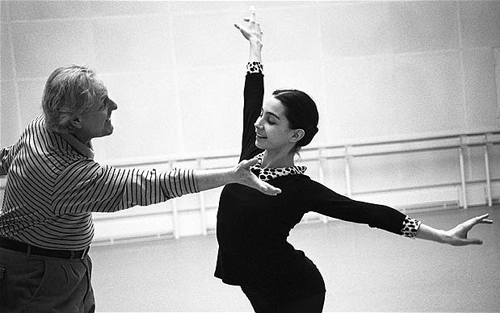Trait versus Process Correction and Praise
Author: Dr. Kveton-Bohnert on behalf of the IADMS Dance Educators' Committee
Every dance class includes correction. Teachers serve as talking mirrors. Without feedback, dancers cannot develop discernment of detail or learn to self-correct. However, teachers must realize that what they say and how they say it has a marked influence on the dancer’s self-beliefs that manifest as confidence or anxiety. Instructors must be mindful of their phraseology when giving correction and praise.
 David Howard rehearsing Tamara Rojo Photo: Johan Persson (2007). ARENA PAL 1106552
David Howard rehearsing Tamara Rojo Photo: Johan Persson (2007). ARENA PAL 1106552
Do you believe traits are fixed or malleable? I hope you answered malleable; research demonstrates that traits can be diminished or developed.1 The term growth mindset refers to this precept. Teaching from a growth mindset is optimal because it leads to process rather than trait correction and praise.
Growth-oriented instructors offer constructive suggestions; their key word is “yet.” For example, “You don’t have your double pirouette yet, but try this.” Or “Your ankles have insufficient flexibility for pointe work yet, but these exercises may help.” This is a constructive way to offer correction because it offers a path toward incremental skill-mastery. Students in a process-oriented classroom will assimilate correction more readily and will gain greater resilience and confidence with less performance anxiety because their instructor expresses that growth and change are possible. Classwork focuses on how specific efforts yield specific results.
Conversely, fixed-trait commentary develops an always or never fixed mindset: “You never point your feet” or “You always fall out of your turns.” This is a nonproductive and destructive form of correction because such statements offer no path toward change or growth. The student feels powerless, criticized, anxious, and defeated. Fixed-trait beliefs lead to fatalistic views about challenge and heighten fears of failure.2, 4
Even compliments can be trait-based. “You are so talented,” “you are so smart,” or “you have such long legs” are trait-based praises to avoid! Certainly, we mean these as compliments. Nevertheless, trait-praise raises performance anxiety because the recipient cannot identify a specific process to sustain such traits. Consequently, acute fear can arise when a trait-label is challenged. One may not look at all ‘smart’ or ‘talented’ when trying something new; this threatens the label and the loss of approval from those who matter most.1, 2, 3, 4
Process praise reduces performance anxiety because it illuminates a path to achievement. For example, “I see that you focused on your épaulement; now your variation looks more expressive,” or “Now that you are really using your plié, your jumps are getting stronger and higher.” Process praise describes something that the student focused on and its perceivable result. From process praise, students learn to trust that their effort is noticed and that correction and application yield progress. This builds students’ confidence and willingness to face new challenges. Difficulty is not perceived as failure or a threat to a trait. The process-praised student learns that difficulties can be overcome incrementally through application of correction and sustained, directed effort. Thus, these students develop greater confidence, perseverance, and resilience. Focusing on process rather than personal traits when delivering correction and praise is essential for students’ wellbeing.
Lisa Kveton-Bohnert, PhD, dance educator, coach, researcher, licensed myofascial release practitioner
Additional Reading
Dweck, C. S. (2008). Mindset: The new psychology of success. New York, NY: Ballantine Books.
Molden, D. C. & Dweck, C. S. (2006). Finding “meaning” in psychology: A lay theories approach to self-regulation, social perception, and social development. American Psychologist, 61(3), 192-203.
Blackwell, L. S., Trzensniewski, K., & Dweck, C. S. (2005). Implicit theories of intelligence predict achievement across an adolescent transition: A longitudinal study and an intervention. Palo Alto, CA: Stanford University.
Kamins, M. L, & Dweck, C. S. (1999). Person versus process praise and criticism: Implications for contingent self-worth and coping. Developmental Psychology, 35(3), 835-847.
Dweck C. S. (2002) The development of ability conceptions. In A. Wigfield & Eccles (EDS.), The development of achievement motivation (pp. 57-83). New York, NY: Academic Press.
Gunderson, E. A. Gripshover, S. J., Romero, C., Dweck, C. S., Glodin-Meadow, S., & Levine, S. C. (2013). Parent praise to 1-3-year-olds predicts children’s motivational frameworks 5 years later. Child Development, 84(5). 1526-1541. Doi: 10.1111/cdev.12064
Kveton-Bohnert, L. A., (2007). The voices of classical ballet dancers: Alleviating maladaptive perfectionism through resilience, mindful learning, and self-compassion. ProQuest Dissertations & Thesis Global. 10278171
Lovatt, P. (2018). Dance psychology. Norfolk, UK: Dr. Dance Presents.
Mainwaring, L., & Krasnow, D. (2010). Teaching the Dance Class: Strategies to Enhance Skill Acquisition, Mastery, and Positive Self-Image. Journal of Dance Education, 10(1).
Pickard. A. (2012). Schooling the dancer: The evolution of an identity as a ballet dancer. Research in Dance Education 13(1). 25-46.